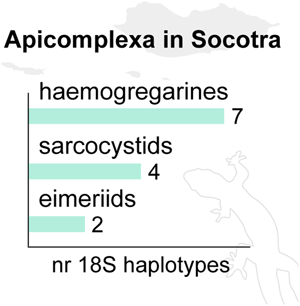Article contents
Parasites in a hotspot: diversity and specificity patterns of apicomplexans infecting reptiles from the Socotra Archipelago
Published online by Cambridge University Press: 19 October 2020
Abstract

Although parasites represent a major component of biodiversity, they remain poorly assessed, especially in remote regions. In this study, we screened 461 reptiles from Socotra, the largest and most biologically diverse archipelago in Arabia. Using 18S rRNA primers, we detected various apicomplexan parasites, namely haemogregarines, sarcocystids and eimeriids. Haemogregarines were the most common and genetically diverse, followed by sarcocystids (genus Sarcocystis) and eimeriids (genera Isospora and Lankesterella). All were related to parasites of other reptiles, including species from Arabia, Northern Africa and Asia. Like their 29 endemic reptile hosts, almost all Socotran parasites presented high genetic divergence and ecological differences from those found elsewhere, and probably represent undescribed endemic species. Among hosts, skinks were the most parasitized, which contrasted with similar studies from other areas, probably due to their more generalist diet and habitat use. As expected due to its high species richness, geckos harboured the highest parasite diversity in the archipelago. Parasite diversity also seemed to be correlated to island size, as the largest island harboured most haplotypes. This study emphasizes the importance of screening parasites in wild hosts from remote regions and of considering host ecology to understand disease transmission across taxa.
- Type
- Research Article
- Information
- Copyright
- Copyright © The Author(s) 2020. Published by Cambridge University Press
References
- 5
- Cited by





